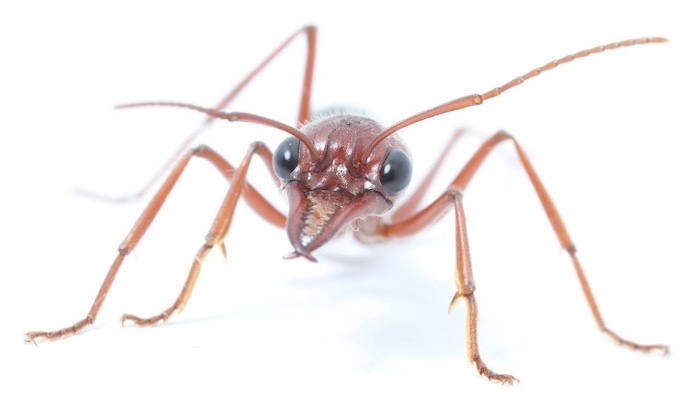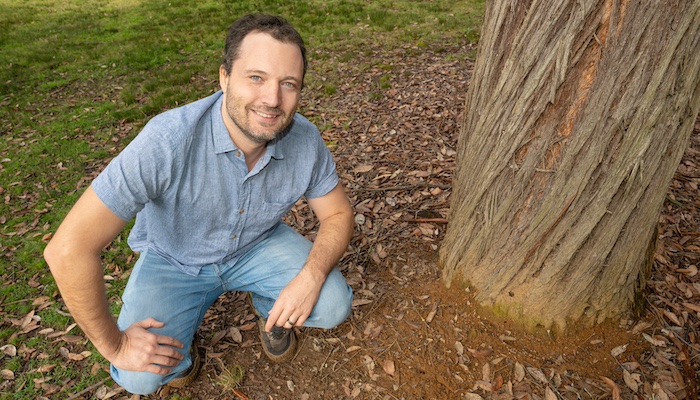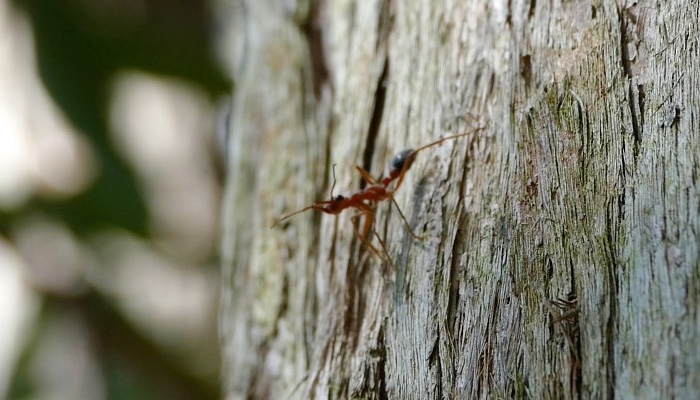In the dark of night, nocturnal ants leave their nests to forage for food, sometimes travelling a substantial distance to and from their destination. But without sunlight and visual cues to guide them, how they find their way in the dark has been a mystery until now.

Lunar compass: Nocturnal bull ants from the Myrmecia midas species can detect polarised moonlight more than a million times dimmer than polarised light patterns from the sun. Image: Ajay Narendra
A team of Macquarie University researchers has studied navigation in specific nocturnal Australian ant species for over a decade. The team's latest findings, published in eLife, reveal how some nocturnal bull ants navigate at night by using the faint pattern of polarised light produced when the sun's light is reflected by the moon – even when that moonlight is barely discernable.
Lead author Dr Cody Freas, a behavioural ecologist and postdoctoral Research Fellow at Macquarie University's School of Natural Sciences, says it can be difficult to assess how nocturnal animals navigate under low light levels.
"We can see them successfully returning home overnight, but we don't understand what cues they're using," says Dr Freas.
Most of the research focused on the nocturnal bull ant species Myrmecia midas, and took place in a forested area on Macquarie University's campus which was affected by urban light pollution.
Despite this, bull ants were able to see a very faint pattern in the night sky produced by moonlight, even when the moon was still below the horizon.
"These ants have highly specialised visual systems able to collect this light cue throughout the night," says Dr Freas.
Polarised light explained
Light waves from the sun or moon can scatter in all directions, but the light waves become aligned, or polarised, in a predictable pattern when they enter Earth's atmosphere.
"Polarised sunglasses are typically oriented vertically so they block horizontally polarised light, the glare that occurs on the horizon during the day," Dr Freas says.
The ants use the polarisation patterns of light to navigate, even in very dim conditions under a crescent moon.

Ant trailing: Dr Cody Freas tracked nocturnal bull-ants through the trees at night to observe moonlight navigation. Image: Chris Bowen
The research team tested the ants' use of polarised light in navigation by placing a large, polarising filter over ants as they scurried home, and then rotating it.
When the filter was rotated, the ants changed direction, showing they were using the polarised light as a kind of celestial compass.
"We showed these ants can detect this cue throughout the lunar month, even when polarised light levels are at their lowest," Dr Freas says.
Night moves
Dr Freas and his team conducted their research in autumn, winter, and spring, when ant behaviour is more consistent, and undertook most of the work between 2am and 4am, when nocturnal ant activity peaks.
"Adult bull ants are primarily vegetarian, feeding on tree sap," Dr Frears says.
"Each night, about a third of the adults in a nest travel up to 20 metres to forage, climbing into the tree canopy to harvest sap."
They found the ants' behaviour changed with the seasons.
"In summer, when the colony has carnivorous larvae to feed, up to a quarter of foragers will hunt for insects and spiders on the ground instead of climbing trees," Dr Freas says.
In the cooler months, a more predictable pattern emerges. "Outside of summer, all foragers go into the trees to eat, often returning to the nest throughout the night.
"We also see a burst of activity at morning twilight, just before sunrise, when light levels start to increase significantly."
He says that ants will time their foraging trips around the moon's schedule, and when there's no moon in the sky at all, ants wait for pre-dawn light to use the sun's position to navigate
"Under a full moon, more ants leave the nest to forage and a greater percentage return throughout the night; but during a new moon, the few ants that venture out will stay in the trees until morning twilight, using the increasing light levels at dawn as a trigger to return to the nest when lunar cues are unavailable."
To track the ants' movements, the researchers had to get creative, using tiny dabs of paint to mark individual ants.
"To tell individual ants apart, we painted their abdomen with a combination of colours; so one dab of red and one of yellow will always be ant number 32, for example."
Holding an ant still enough to paint it was a challenge, says Dr Freas, explaining researchers used pins dabbed in paint to mark their bodies.
This painstaking work saw the researchers follow bull ants as they travelled across the ground, marking the ground behind their path before and after they used a polarising filter above the ant.
Wider impact
The research on nocturnal Australian bull ants has broader implications for understanding how other nocturnal insects and even mammals might navigate by the light of the moon.

It could also inspire new designs for navigation systems in robots and autonomous vehicles.
"We show that ants which have a brain the size of a pinhead also have highly sensitive visual acuity and a sensory system highly tuned to very weak cues," says Dr Freas.
Most ant species aren't nocturnal, and ants are known to use the sun's polarisation patterns to navigate.
"By adapting their daytime sun-based navigation to work with much dimmer moonlight, these nocturnal bull ants have developed a versatile system that works around the clock," he says.
Understanding how ants use moonlight and polarised light to navigate with minimal processing power, could help us develop robotic navigation that works in low-light conditions, he adds.
"A miniature robot with very small processing power could potentially use a sensor that is highly tuned enough to see lunar polarisation, integrated into a simple navigational toolbox like an ant has – and then you can enable nocturnal navigation."
The research is continuing, with plans to further investigate lunar navigation in bull ants in other parts of Australia and to explore whether these ants also use starlight patterns to navigate.
Cody Freas is a Macquarie University Research Fellow (MQRF), School of Natural Sciences.






